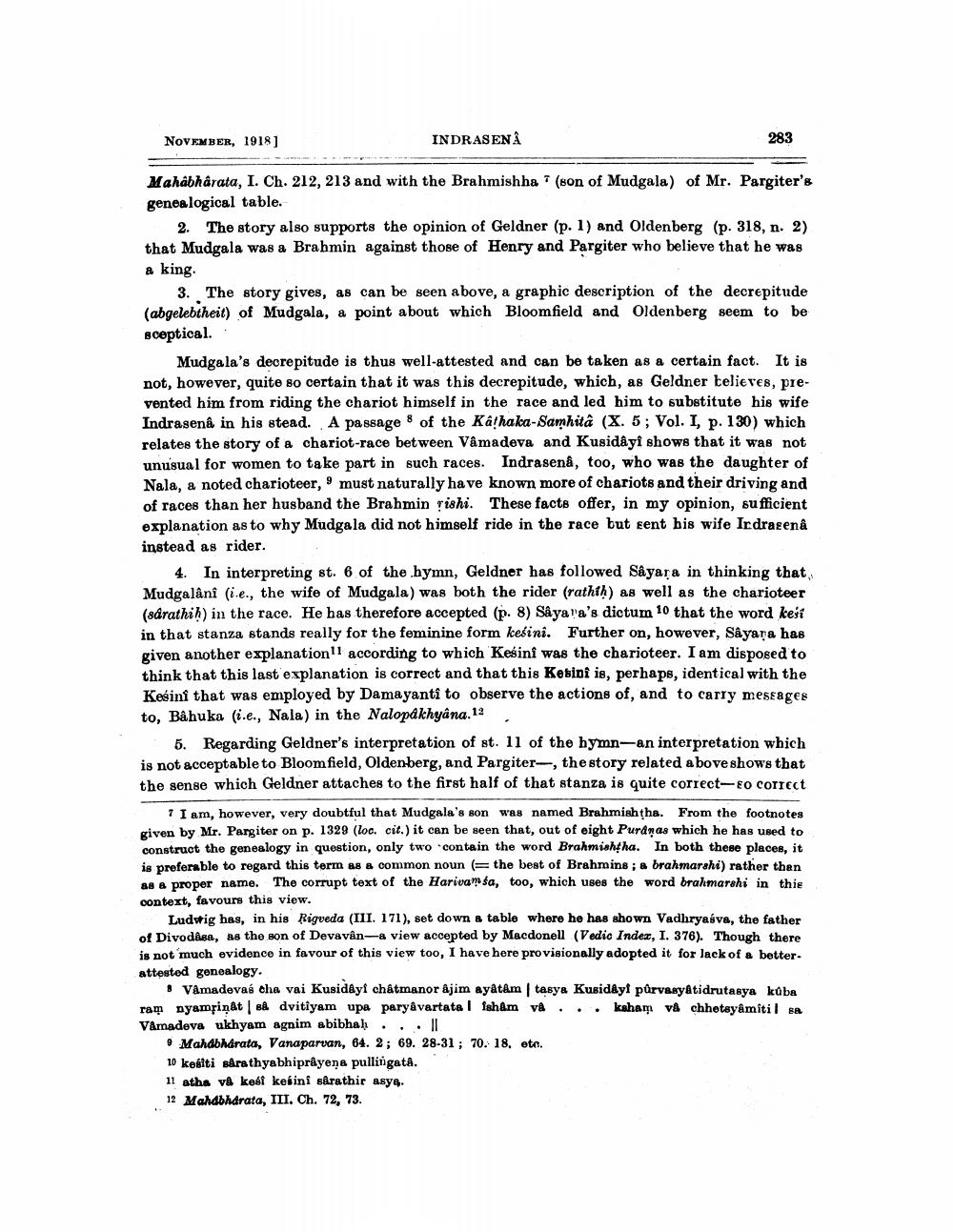________________
NOVEMBER, 1918)
INDRASEN Å
283
Mahabharata, I. Ch. 212, 213 and with the Brahmishha (son of Mudgala) of Mr. Pargiter's genealogical table.
2. The story also supports the opinion of Geldner (p. 1) and Oldenberg (p. 318, n. 2) that Mudgala was a Brahmin against those of Henry and Pargiter who believe that he was a king.
3. The story gives, as can be seen above, a graphic description of the decrepitude (abgelebtheit) of Mudgala, a point about which Bloomfield and Oldenberg seem to be sceptical.
Mudgala's decrepitude is thus well-attested and can be taken as a certain fact. It is not, however, quite so certain that it was this decrepitude, which, as Geldner believes, prevented him from riding the chariot himself in the race and led him to substitute his wife Indrasena in his stead. A passage of the Ka!haka-Samhita (X. 5; Vol. I, p. 130) which relates the story of a chariot-race between Vâmadeva and Kusidâyi shows that it was not unusual for women to take part in such races. Indrasena, too, who was the daughter of Nala, a noted charioteer, must naturally have known more of chariots and their driving and of races than her husband the Brahmin rishi. These facts offer, in my opinion, sufficient explanation as to why Mudgala did not himself ride in the race but sent his wife Irdracena instead as rider.
4. In interpreting st. 6 of the hymn, Geldner has followed Sayara in thinking that Mudgalâni (ie., the wife of Mudgala) was both the rider (rathth) as well as the charioteer (sdrathih) in the race. He has therefore accepted (p. 8) Sayava's dictum 10 that the word kesi in that stanza stands really for the feminine form kešini. Further on, however, Sâyara has given another explanation'1 according to which Kesini was the charioteer. I am disposed to think that this last explanation is correct and that this Kesini is, perhaps, identical with the Kesini that was employed by Damayanti to observe the actions of, and to carry mese ages to, Bahuka (i.e., Nala) in the Nalopakhyana 12
5. Regarding Geldner's interpretation of st. 11 of the hymn-an interpretation which is not acceptable to Bloomfield, Oldenberg, and Pargiter-, the story related above shows that the sense which Geldner attaches to the first half of that stanza is quite correct-EO Correct
I am, however, very doubtful that Mudgala's son was named Brahmishtha. From the footnotes given by Mr. Pargiter on p. 1329 (loc. cit.) it can be seen that, out of eight Puranas which he has used to construct the genealogy in question, only two contain the word Brahmishtha. In both these places, it is preferable to regard this term as a common noun the best of Brahmins ; a brahmarahi) rather than as a proper name. The corrupt text of the Harivam sa, too, which uses the word brahmarshi in thie context, favours this view.
Ludwig has, in his Rigveda (III. 171), set down & table where he has shown Vadhryaśva, the father of Divodása, as the son of Devavân-a view accepted by Macdonell (Vedic Index, I. 376). Though there is not much evidence in favour of this view too, I have here provisionally adopted it for lack of a better. attested genealogy.
, Vámadeva che vai Kusidây châtmanor âjim ayatâm | tasya Kusidêyl půrvasyâtidrutasya kuba ram nyamrinat | Bê dvitiyam upa paryavartate I fshêm và ... kham và chheteyomitil Ea VAmadova ukhyam agnim abibhah...
o Mahabharata, Vanaparvan, 64. 2; 69. 28-31; 70. 18. eto. 10 kesiti såra thyabhiprayena pullingata. 11 atha va kesi kesini sârathir asye. 12 Mandbharata, III. Ch. 72, 73.




